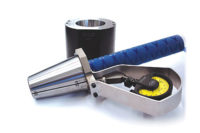I love to cook and for the most part, it is a precise science…at least when you are first learning how to do it.
Unfortunately this means that you cannot simply add a pinch of this, throw in a handful of that and expect the recipe to turn out right. While there can be much creativity in cooking, when it comes to measurements, accuracy is important. Each recipe is a mathematical formula that when followed closely, results in a great dish. Without accurate measurements, the end product can range from bad to inedible.
So I determined early on that I needed to invest in precision measuring tools for cooking if I wanted to avoid demoralizing kitchen failures. This lead me to purchase items such as glass Pyrex cups for measuring liquids; measuring scoops and spoons in a variety of sizes for dry ingredients; and a food scale for following a European recipe.
Just like there is no one-size-fits-all cooking measurement tool in my kitchen, there is no all-purpose precision measurement tool used in the manufacturing and production industries. In fact, there are many.
Being fairly new to precision measuring tools used in these industries, I had very little knowledge about the basics of this instrumentation, the principles behind them, their use in various applications, etc. So when I was given the chance to write about depth gages, needless to say I was concerned at first about “cooking something up.” But then I saw it as a great opportunity to dish up this information in an easily digestible serving to make sense out of the technical jargon.
Some Interesting Tidbits of Information on Depth Gages
There are many ways to check a depth dimension on a part. To determine the current depth (inside length) of any object, which is the distance between two points/two surfaces, a depth gage is among the simplest of indicator gages. It generally consists of a short-range indicating device, mounted through a reference bar or plate.
However, don’t let its simplicity fool you. Depth gages are used in all kinds of product manufacturing, production, machining or assembly applications to accurately measure the depth of holes, recesses, cutouts, crevices, machined cavities, counter bores, slots, grooves, keyways, etc., or any other surface of an object. Utilizing this tool, equipment life and efficiency can be increased and breakdown costs reduced.
Over time, depth gages have changed from simple mechanical rules and scales, to Vernier and micrometer depth gages, to digital versions as the need for precision and high-resolution has increased. Since then, all have been replaced with electronic versions, which offer even greater levels of accuracy, speed of operation and reduced reliance on individual skill.
Depth gages can be of scale, dial, digital or electronic type and vary in their readouts—from simple direct reading tic marks, to digitally displayed numerals, to measurements automatically registered directly to an LCD display. They are designed to be handheld or portable and can be readily modified to suit particular application needs.
The simplest and most common depth gages are manually operated and use simple physical mechanisms to measure the depth of an opening from a flat surface. They are generally available in the measuring scale of an inch or cm. Additionally they are typically about 150mm long and can easily measure depths up to 1,000 millimeters.
A commonly used variety (where precision is not a high priority) consists of a narrow graduated rule and has etched, quick-read markings; a sliding head designed to bridge a hole or slot and through which the ruler can slide up or down; and a locking screw on the cover to clamp the ruler in place at any point. The head, which is machined flat and at right angles to the ruler, is placed on a reference surface, while the ruler is lowered into the opening, until it bottoms. The center of the head typically features a recess cutout for easy reading. Measurements can be taken through the markings on the ruler itself, or through digital displays. Some depth gages can also be used to measure angles. This is done by using the angle marks located on the sliding head.
Today, depth gages are available with various styles of indicators, contact points and bases and come in various configurations, depending on the specific application. The latest types include electronic tire thread depth gages, electronic depth gages, single hook type electronic depth gages, needle electronic depth gages, double hooks electronic depth gages, electronic depth gages with adjustable base, Vernier depth and dial depth gages.
Different Depth Gage Types
It is important to understand that when inspecting parts, measuring and gaging have two very different meanings, just like in cooking. The main distinction has to do with the count of units: measuring refers to the number of units in the specified dimensions of a part (giving it an exact, numeric value). Gaging refers to whether the part features are within a specified limit, without actually having to measure it (giving it a rough estimate). The choice of inspection tools (measuring or gaging) is generally determined by what type of measurement is needed.
On the basis of type, depth gages are generally regarded as follows:
- Fixed – used to compare a part to an external standard (not a built-in reference scale) and indicates whether a given dimension is larger or smaller than the external standard.
- Variable (Deviation-Type) – used to indicate the amount by which the part being gaged deviates from the external standard and is generally shown in units of measurement. However, some show only whether the deviation is within a certain range.
- Micrometer Type – used to measure small distances. Utilizes the barrel of the micrometer as the measuring leg and allows for entry into smaller holes. Provides for absolute, rather than comparative gaging and offers extremely good resolution over their entire range. However, since they have a limited measurement span, they often come in varying sizes to accommodate user needs.
- Caliper Type – similar to the micrometer type. Can be used to measure inside and outside diameters, as well as depths. However, using this type as a depth gage is not really what the tool is designed to do. It is extremely difficult to align and hold the caliper square while making a depth check, as the end of the caliper is not designed for stability.
- Dial Indicator Type (Distance Amplifier) – utilized in different tools to measure small distances, angles and amplify them to make them more obvious. Named for its clock-like face, it consists of numbers arranged in a circle which a dial points to. Several different types exist differentiated by their size, connection method and the type of data displayed on their face.
Various Categories of Depth Gages
There are different depth gage categories. Below are examples of how each can be used:
- Vernier Depth Gages – used to measure hole depth of die from a given surface. They have a scale that increases the level of precision when taking measurements. Graduations are printed or engraved onto a surface (drum or linear).
- Depth & Angle Gages – used to measure the depth of small holes and slots, as well as for measuring and marking outside, inside and sloped angles of a surface.
- Rule Depth Gages – used to measure the depth of holes, cutouts, openings, grooves, recesses, etc. Enables quick measurements when and where precision is not a top priority.
- Flush-Pin Gages – used to measure the depth of holes or shoulders. They are also used to inspect counter shanks and counter bores.
- Thread Depth Gages – used to measure the depth of the thread surface in a hole.
- Micrometer Depth Gages – used to measure the depths of holes, slots and steps with micrometer precision. They come in two different configurations: one for measuring inside dimensions and one for outside dimensions. They come with a variety of interchangeable rods of different lengths to increase their range.
- Electronic Depth Gages – one of the fastest and most accurate tools for checking the depths of slots, holes, recesses, etc. Measurements are automatically registered directly to an LCD display.
- Dial Depth Gages – used to measure depths of holes, recesses, slots, scratches and paint thicknesses. Utilize a needle or pointer that is mounted in a gradual disc-dial to display data. The dial indicates positions and dimensions from a reference point. Dial display options include an analog amplifier, one or multi-revolution capabilities and clockwise and counter-clockwise rotation.
The Importance of Precision Measuring Tools both in the Kitchen and on the Shop Floor
Though cooking without precision measuring tools in the kitchen can be a bit more forgiving than on the shop floor, utilizing the right depth gage and being knowledgeable in its use is a critical quality control decision in the manufacturing and production industries. Without accurate measurements, incorrect data can lead to wrong or even dangerous conclusions, affect the cost and performance of the parts inspected and turn out to be a recipe for disaster. Q



